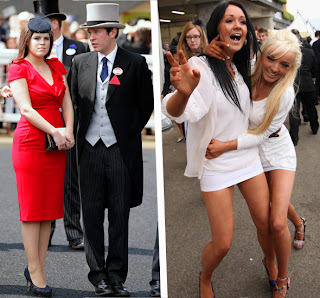“When attacked from behind, she grasps a hatpin. Turning quickly, she is able to strike a fatal blow in the face.”
Fellow Etsy milliner Susan of
Inspired hats recently sent me a link to a great article originally featured on
The Bartitsu Society web site about the use of hat pins in self defence. It was just too funny to not share.
The popular trend towards enormous, flamboyant hats reached its zenith during the Edwardian era. Circa 1900, fashionable ladies’ headwear featured elaborate assemblies of taffeta, silk bows, coloured ostrich feathers, flowers and even artificial fruit.
The mainstay of the Edwardian hat was the artfully concealed hatpin, and as the hats themselves grew ever larger, so too did the pins. Some antique examples are thirteen inches long and resemble nothing so much as unbated, miniature fencing foils.
A wealth of evidence from the period demonstrates that hatpins were popularly regarded as secret weapons, and indeed as “every woman’s weapon” against the depredations of hooligans and ill-mannered brutes. Laws against hatpins of “excessive length”, or the wearing of hatpins without protective stoppers, were proposed in Hamburg, Berlin and New York among other cities. At least ostensibly, these laws were intended not so much to ban the use of hatpins in self-defence as to mitigate the incidence of accidental hatpin related injuries inflicted upon blameless fellow passengers in crowded tram-cars.
Certainly, though, the hatpin was the weapon of choice for Edwardian novelists and playwrights who had to extricate their heroines from tight spots.
From Harold MacGrath’s novel “Parrot & Co”, 1914:
Craig stepped in front of them, smiling as he raised his helmet. “This is an unexpected pleasure.”
Elsa, looking coldly beyond him, attempted to pass.
“Surely you remember me?”
“I remember an insolent cad,” replied Elsa, her eyes beginning to burn dangerously. “Will you stand aside?”
He threw a swift glance about. He saw with satisfaction that none but natives was in evidence.
Elsa’s glance roved, too, with a little chill of despair. In stories Warrington would have appeared about this time and soundly trounced this impudent scoundrel. She realized that she must settle this affair alone. She was not a soldier’s daughter for nothing.
“Stand aside!”
“Hoity-toity!” he laughed. He had been drinking liberally and was a shade reckless. “Why not be a good fellow? Over here nobody minds. I know a neat little restaurant. Bring the old lady along,” with a genial nod toward the quaking Martha.
Resolutely Elsa’s hand went up to her helmet, and with a flourish drew out one of the long steel pins.
“Oh, Elsa!” warned Martha.
“Be still! This fellow needs a lesson. Once more, Mr. Craig, will you stand aside? ”
Had he been sober he would have seen the real danger in the young woman’s eyes.
“Cruel!” he said. ” At least, one kiss,” putting out his arms.
Elsa, merciless in her fury, plunged the pin into his wrist. It stung like a hornet; and with a gasp of pain, Craig leaped back out of range, sobered.
“Why, you she-cat!”
“I warned you,” she replied, her voice steady but low. “The second stab will be serious. Stand aside.”
He stepped into the gutter, biting his lips and straining his uninjured hand over the hurting throb in his wrist. The hat-pin as a weapon of defense he had hitherto accepted as reporters’ yarns. He was now thoroughly convinced of the truth. He had had wide experience with women. His advantage had always been in the fact that the general run of them will submit to insult rather than create a scene. This dark-eyed Judith was distinctly an exception to the rule. Gad! She might have missed his wrist and jabbed him in the throat. He swore, and walked off down the street.
Elsa set a pace which Martha, with her wabbling knees, found difficult to maintain.
“You might have killed him!” she cried breathlessly.
“You can’t kill that kind of a snake with a hat-pin; you have to stamp on its head. But I rather believe it will be some time before Mr. Craig will again make the mistake of insulting a woman because she appears to be defenseless.” Elsa’s chin was in the air. The choking sensation in her throat began to subside. “The deadly hat-pin; can’t you see the story in the newspapers? Well, I for one am not afraid to use it.”
Perhaps less frequently than in popular fiction, but still present in newspaper articles and medical journals of the time, we find reports of women wounding male attackers via well-placed jabs with their hatpins. For example, according to a story in the New York Times of January 10, 1898, a Miss Sadie Hawkins assisted a Chicago tram-car conductor named Symington in fending off two determined would-be robbers by stabbing them both repeatedly in the arms and legs with her hatpin, causing the aggressors so much grief that they jumped off the moving tram to escape the onslaught.
Hatpins were also apparently among the covert weapons used by Suffragettes in their struggles against the London bobbies, augmenting their judicious use of Indian clubs and jujitsu.
Unfortunately there is a paucity of technical instruction on the hatpin as a weapon. The picture emerges, though, of a two-phase counter-strategy against over-confident ruffians who seized their intended victims by the shoulders or arms. First, the defender would feign shock and indignation, her hand flying up apparently to steady her enormous hat, but in reality to pluck out a hatpin. Then, in one movement, she would jab the weapon forcefully into the offending hand or wrist; Mr. MacGrath was not the only writer to compare the resulting pain to “the sting of a hornet”. This might well suffice to discourage any further offence. If not, the consensus on following-up was to stab the assailant in the face or, if more conveniently accessible, “the place where it hurts the most”.
































